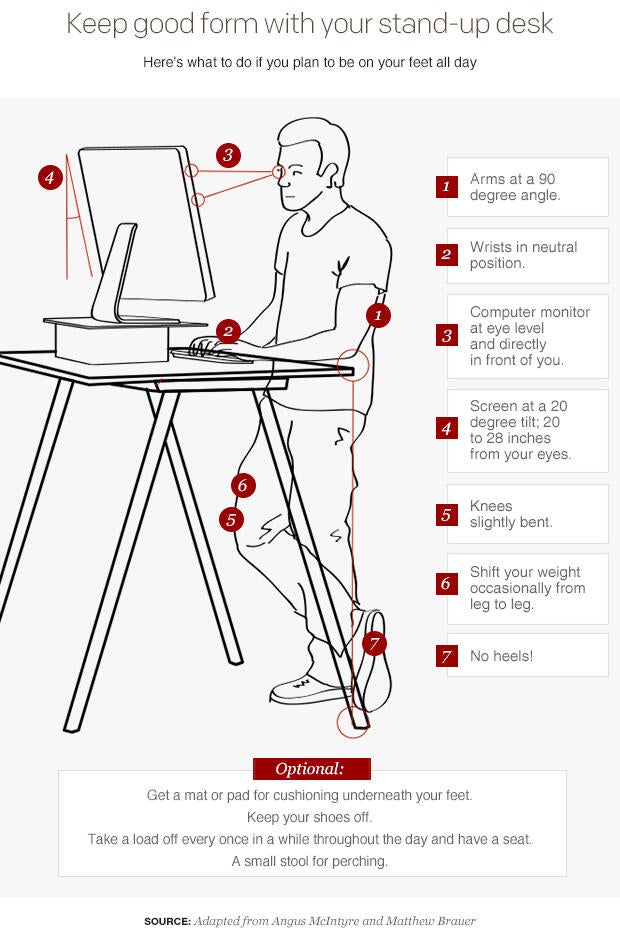Sitting is the new smoking, they say, and studies have linked too many hours on your duff to an increased risk for heart disease,
diabetes, cancer and early death. Not even regular exercise can counteract the health impact of sitting all day long.
But as a newbie, you probably wonder if you're using that brand new standing desk correctly and even, perhaps,
if you're doing your aching feet some harm by standing too much during the day. Here's what you need to know.

First, the benefits: Experts say that working at a standing desk instead of sitting all day long can reduce the risk for a number of health conditions including obesity, type 2 diabetes, cardiovascular disease and cancer. A study published in the American Journal of Epidemiology and conducted by researchers at the American Cancer Society suggests people who sit for long periods of time have an increased risk of disease and a shorter average life span. Another study conducted by the U.S. Centers for Disease Control and Prevention in 2011 found when workers used standing desks and reduced their sitting time by about an hour a day, they reduced their upper back and neck pain by 54 percent and experienced improvements in mood.
You'll also burn more calories standing while you work rather than slumped in your chair. (Don't worry, eventually you'll be able to retire.)
Dr. Jason Freedman, a specialist in orthopedic surgery, sports medicine and arthroscopy and shoulder reconstruction at Cambridge Health Alliance, told CBS News that standing desks certainly have their health benefits and can help with a number of postural problems people caused by sitting too much. But standing desks are not a panacea.
In general, the human body may not be able to tolerate standing all day pain-free."The way the human spine is designed, we're not quite designed to be completely erect," said Freedman. "In the course of evolution the spine will be more mechanically sound for being erect."
So while we all wait for evolution and office culture to get on the same page, it's important to be mindful of your posture and work station set-up.
Using a standing desk won't eliminate all your aches and pains. More likely, a different group of muscles will probably hurt. People who sit for much of their work life complain of sore shoulders, neck and upper back pain. But standing up for the entire day impacts a different muscle group altogether. Standing desk aficionados tend to experience more pain in the lower back, legs and feet.
"If your body is using the same muscles, the same way all the time, you're going to experience strain," said Freedman. "When you're standing in one place, the muscles are still working to keep you erect. Your back muscles, the muscles in your core, are still working to keep you up straight."
This is why some experts advocate you take breaks from standing.
Dr. Rob DeStefano, a chiropractor in private practice in New York City, recommends alternating back and forth between sitting and standing. "It is best to do 30 minutes of each for most people, but if one is used to sitting, increase the amount of sitting time to about 45 minutes and 30 minutes standing would be better," he told CBS News. "Yes, standing too much can become uncomfortable and irritate the hips or back if they have any prior injuries." He recommends purchasing an adjustable desktop that balances on a regular desk and moves up and down, rather than a stationary standing desk unit. This way you won't feel like you're stuck constantly on your feet.
As is the case with yoga and weight training, form is everything. Improper set-up or positioning of your standing desk will leave you extra achy and may cause numbness in your arms and hands, as well as feet that feel like they've walked way too many miles.
"The most common mistake people make when standing is to lock their knees. It is advised to have a little bend in the knees to take pressure off of your back and allow for better circulation to the legs," said DeStefano.
If you've decided to stand in the place where you work, be sure that your desk is set up at an appropriate height. Your computer monitor should be at eye level and directly in front of you. Your screen should tilt up just a smidgen, and should be at least 20 inches away from your face.
Keep your arms at a 90 degree angle to prevent shoulder and neck strain. Your wrists should be in a neutral position, not curved up or down. It is a good idea to shift your weight occasionally from one foot to the other; most likely you'll do that naturally.
Some people like to get a cushioned floor mat to stand on. And adjust your office footwear accordingly -- it may not be as fashionable, but wear comfortable flat shoes or even go without shoes when standing at your desk.
Credit: Graphic adapted from Angus McIntyre and Matthew Brauer/CC BY-SA 1.0 http://creativecommons.org/licenses/by-sa/1.0















